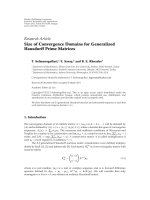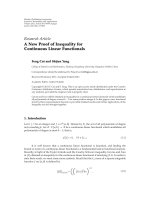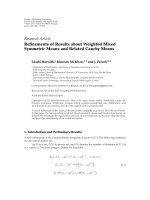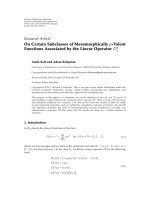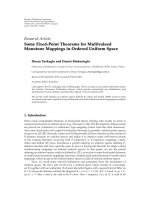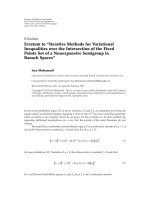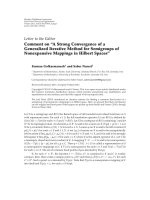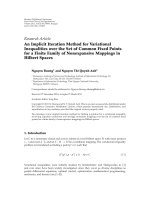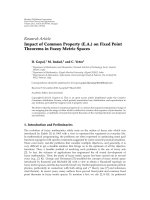Hindawi Publishing Corporation Fixed Point Theory and Applications Volume 2010, Article ID 340631, ppt
Bạn đang xem bản rút gọn của tài liệu. Xem và tải ngay bản đầy đủ của tài liệu tại đây (500.2 KB, 12 trang )
Hindawi Publishing Corporation
Fixed Point Theory and Applications
Volume 2010, Article ID 340631, 12 pages
doi:10.1155/2010/340631
Research Article
Measures of Noncircularity and Fixed Points of
Contractive Multifunctions
Isabel Marrero
Departamento de An
´
alisis Matem
´
atico, Universidad de La Laguna, 38271 La Laguna (Tenerife), Spain
Correspondence should be addressed to Isabel Marrero,
Received 24 October 2010; Accepted 8 December 2010
Academic Editor: N. J. Huang
Copyright q 2010 Isabel Marrero. This is an open access article distributed under the Creative
Commons Attribution License, which permits unrestricted use, distribution, and reproduction in
any medium, provided the original work is properly cited.
In analogy to the Eisenfeld-Lakshmikantham measure of nonconvexity and the Hausdorff measure
of noncompactness, we introduce two mutually equivalent measures of noncircularity for Banach
spaces satisfying a Cantor type property, and apply them to establish a fixed point theorem of
Darbo type for multifunctions. Namely, we prove that every multifunction with closed values,
defined on a closed set and contractive with respect to any one of these measures, has the origin as
a fixed point.
1. Introduction
Let X, · be a Banach space over the field K ∈{R, C}. In what follows, we write B
X
{x ∈
X : x≤1} for the closed unit ball of X. Denote by 2
X
the collection of all subsets of X and
consider
b
X
:
C ∈ 2
X
\
{
∅
}
: C bounded
. 1.1
For C, D ∈ bX, define their nonsymmetric Hausdorff distance by
h
C, D
: sup
c∈C
inf
d∈D
c − d
1.2
2 Fixed Point Theory and Applications
and their symmetric Hausdorff distance or Hausdorff-Pompeiu distance by
H
C, D
: max
{
h
C, D
,h
D, C
}
. 1.3
This H is a pseudometric on bX,since
H
C, D
H
C, D
H
C, D
H
C, D
, 1.4
where
A denotes the closure of A ∈ 2
X
.
Around 1955, Darbo 1 ensured the existence of fixed points for so-called condensing
operators on Banach spaces, a result which generalizes both Schauder fixed point theorem
and Banach contractive mapping principle. More precisely, Darbo proved that if M ∈ bX
is closed and convex, κ is a measure of noncompactness, and f : M → M is continuous
and κ-contractive, that is, κfA ≤ rκAA ∈ bM for some r ∈0, 1, t hen f has a fixed
point. Below we recall the axiomatic definition of a regular measure of noncompactness on
X; we refer to 2 for details.
Definition 1.1. A function κ : bX → 0, ∞ will be called a regular measure of
noncompactness if κ satisfies the following axioms, for A, B ∈ bX,andλ ∈ K:
1 κA0if,andonlyif,
A is compact.
2 κco AκAκ
A, where co A denotes the convex hull of A.
3monotonicity A ⊂ B implies κA ≤ κB.
4maximum property κA ∪ Bmax{κA,κB}.
5homogeneity κλA|λ|κA.
6subadditivity κA B ≤ κAκB.
A regular measure of noncompactness κ possesses the following properties:
1 κA ≤ κB
X
δA, where
δ
A
: sup
x,y∈A
x − y
1.5
is the diameter of A ∈ bXcf. 2, Theorem 3.2.1.
2Hausdorff continuity |κA − κB|≤κB
X
HA, BA, B ∈ bX 2, page 12.
3Cantor property If {A
n
}
∞
n0
⊂ bX is a decreasing sequence of closed sets with
lim
n →∞
κA
n
0, then A
∞
∞
n0
A
n
/
∅,andκA
∞
0 3, Lemma 2.1.
In Sections 2 and 3 of this paper we introduce two mutually equivalent measures of
noncircularity, the kernel that is, the class of sets which are mapped to 0 of any of them
consisting of all those C ∈ bX such that
C is balanced. Recall that A ∈ 2
X
\{∅}is balanced
provided that μA ⊂ A for all μ ∈ K with |μ|≤1. For example, in R the only bounded balanced
sets are the open or closed intervals centered at the origin. Similarly, in C as a complex vector
space the only bounded balanced sets are the open or closed disks centered at the origin,
Fixed Point Theory and Applications 3
while in R
2
as a real vector space there are many more bounded balanced sets, namely all
those bounded sets which are symmetric with respect to the origin.
Denoting by γ either one of the two measures introduced, in Section 4 we prove a
result of Darbo type f or γ-contractive multimaps see Section 4 for precise definitions.Itis
shown that the origin is a fixed point of every γ-contractive multimap F with closed values
defined on a closed set M ∈ bX such that FM ⊂ M.
2. The E-L Measure of Noncircularity
The definition of the Eisenfeld-Lakshmikantham measure of nonconvexity 4 motivates the
following.
Definition 2.1. For C ∈ bX,set
α
C
: H
baC, C
h
baC, C
, 2.1
where baC denotes the balanced hull of C,thatis,
baC :
μc :
μ
≤ 1,c∈ C
. 2.2
By analogy with the Eisenfeld-Lakshmikantham measure of nonconvexity, we shall refer to α
as the E-L measure of noncircularity.
Next we gather some properties of α which justify such a denomination. Their proofs
are fairly direct, but we i nclude them for the sake of completeness.
Proposition 2.2. In the above notation, for C, D ∈ bX, and λ ∈ K, the following hold:
1 αC0 if, and only if,
C is balanced.
2 αco C ≤ αCα
C.
3 αC ∪ D ≤ max{αC,αD}.
4 αλC|λ|αC.
5 αC D ≤ αCαD.
6 αC ≤ 2C,where
C : sup
c∈C
c
2.3
is the norm of C. In particular, if 0 ∈ C then αC ≤ 2δC,where
δ
C
: sup
x,y∈C
x − y
2.4
is the diameter of C.
7 |αC − αD|≤2HC, D.
4 Fixed Point Theory and Applications
Proof. Let
baC denote the closed balanced hull of C. The identity
ba C baC
2.5
holds. Indeed,
C ⊂ baC implies ba C ⊂ baC. Conversely, C ⊂ ba C implies baC ⊂ ba C.
1 By definition, αCHbaC, ChbaC, C0if,andonlyif,baC ⊂
C or,
equivalently,
baC ⊂ C. This means that baC C, which by 2.5 occurs if, and
only if,
C is balanced.
2 In view of 1.4 and 2.5,
α
C
H
ba
C, C
H
ba C, C
H
baC, C
H
baC, C
α
C
.
2.6
It only remains to prove that αco C ≤ αC. Suppose αC <ε,sothatbaC ⊂
CεB
X
.ThesetcoCεB
X
being convex, it follows that bacoC ⊂ cobaC ⊂ co CεB
X
,
whence αco C ≤ ε. From the arbitrariness of ε we conclude that αco C ≤ αC.
3 Assume max{αC,αD} <ε,thatis,αC <εand αD <ε. Then baC ⊂ C εB
X
,
baD ⊂ D εB
X
, and the fact that baC∪baD is a balanced set containing C ∪D,imply
ba
C ∪ D
⊂ baC ∪ baD ⊂
C ∪ D
εB
X
, 2.7
whence αC ∪ D ≤ ε. The arbitrariness of ε yields αC ∪ D ≤ max{αC,αD}.
4 For λ 0, this is obvious. Suppose λ
/
0. If |λ|αC <εthen baC ⊂ C ε/|λ|B
X
C ε/λB
X
, whence baλC λbaC ⊂ λC εB
X
.ThusαλC ≤ ε,andfromthe
arbitrariness of ε we infer that αλC ≤|λ|αC. Conversely, assume αλC <ε.
Then baλC ⊂ λC εB
X
, whence baC 1/λbaλC ⊂ C ε/λB
X
C ε/|λ|B
X
.
Therefore αC ≤ ε/|λ|, and from the arbitrariness of ε we conclude that |λ|αC ≤
αλC.
5 Let αCαD <εand choose ε
1
,ε
2
> 0 such that ε ε
1
ε
2
, αC <ε
1
and
αD <ε
2
. Then baC ⊂ C ε
1
B
X
,baD ⊂ D ε
2
B
X
and the fact that baC baD is a
balanced set containing C D, imply baC D ⊂ baC baD ⊂ C D εB
X
,sothat
αC D ≤ ε. The arbitrariness of ε yields αC D ≤ αCαD.
6 Pick x μu ∈ baC,with|μ|≤1andu ∈ C,andletc ∈ C.As
x − c μu − c≤
μ
u c≤2C, 2.8
we obtain
α
C
sup
x∈baC
inf
c∈C
x − c≤2C≤2δ
C
,
2.9
where for the validity of the latter estimate we have assumed 0 ∈ C.
Fixed Point Theory and Applications 5
7 It is enough to show that
α
C
≤ α
D
h
C, D
h
D, C
, 2.10
since then, by symmetry,
α
D
≤ α
C
h
C, D
h
D, C
, 2.11
whence the desired result. Now
α
C
H
baC, C
h
baC, C
≤ h
baC, baD
h
baD, D
h
D, C
h
baC, baD
α
D
h
D, C
.
2.12
To complete the proof we will establish that hbaC, baD ≤ hC, D. Indeed, suppose
hC, D <ε,andletx μc ∈ baC,with|μ|≤1andc ∈ C. Then there exists d ∈ D such
that c − d <ε. Consequently, for y μd ∈ baD we have
x − y μc − μd
μ
c − d <ε. 2.13
This means that baC ⊂ baD εB
X
,sothathbaC, baD ≤ ε. From the arbitrariness of ε we
conclude that hbaC, baD ≤ hC, D.
Remark 2.3. The identity αco CαCC ∈ bX may not hold, as can be seen by choosing
C {−1, 1}∈2
R
.Infact,coC −1, 1 is balanced, while C is not. Therefore, αco C0 <
αC.
In general, the identity αC ∪ Dmax{αC,αD} C, D ∈ bX does not hold
either. To show this, choose C and D, respectively, as the upper and lower closed half unit
disks of the complex plane. Then C ∪ D equals the closed unit disk, which is balanced, while
C, D are not. Thus, αC ∪ D0 < max{αC,αD}.
Note that α is not monotone: from C, D ∈ bX and C ⊂ D, it does not necessarily
follow that αC
≤ αD. Otherwise, αD0 would imply αC0, which is plainly false
since not every subset of a balanced set is balanced.
3. The Hausdorff Measure of Noncircularity
The following definition is motivated by that of the Hausdorff measure of noncompactness
cf. 2, Theorem 2.1.
Definition 3.1. We define the Hausdorff measure of noncircularity of C ∈ bX by
β
C
: H
C, bb
X
inf
B∈bbX
H
C, B
,
3.1
where bbX denotes the class of all balanced sets in bX.
6 Fixed Point Theory and Applications
In general, αC
/
βC, as the next example shows.
Example 3.2. Let C {1}∈2
R
. Then baC −1, 1,and
α
C
sup
|
x
|
≤1
|
x − 1
|
2.
3.2
If B
r
−r, rr ≥ 0 is any closed bounded balanced set in R, we have
h
C, B
r
inf
|
x
|
≤r
|
x − 1
|
,h
B
r
,C
sup
|
x
|
≤r
|
x − 1
|
,
3.3
so that
H
C, B
r
max
{
h
C, B
r
,h
B
r
,C
}
h
B
r
,C
. 3.4
Since
h
B
r
,C
sup
|
x
|
≤r
|
x − 1
|
1 r,
3.5
we obtain
β
C
inf
r≥0
H
C, B
r
inf
r≥0
1 r
1.
3.6
Thus, 2βC2 αC.
Next we compare the measures α and β and establish some properties for the
latter. Again, most proofs derive directly from the definitions, but we include them for
completeness.
Proposition 3.3. In the above notation, for C, D ∈ bX, and λ ∈ K, the following hold:
1 βC ≤ αC ≤ 2βC, and the estimates are sharp.
2 βC0 if, and only if,
C is balanced.
3 βco C ≤ βCβ
C.
4 βC ∪ D ≤ max{βC,βD}.
5 βλC|λ|βC.
6 βC D ≤ βCβD.
7 βC ≤ 2C,where
C : sup
c∈C
c
3.7
Fixed Point Theory and Applications 7
is the norm of C. In particular, if 0 ∈ C then βC ≤ 2δC,where
δ
C
: sup
x,y∈C
x − y
3.8
is the diameter of C.
8 |βC − βD|≤HC, D.
Proof. 1 That βC ≤ αC follows immediately from the definitions of β and α.Letε>2βC
and choose B ∈ bbX satisfying HC, B <ε/2, so that C ⊂ B ε/2B
X
and B ⊂ C ε/2B
X
.
Then baC ⊂ B ε/2B
X
and B ⊂ baC ε/2B
X
, thus proving that HbaC, B ≤ ε/2. Now
α
C
H
baC, C
≤ H
baC, B
H
B, C
<ε, 3.9
and the arbitrariness of ε yields αC ≤ 2βC. Example 3.2 shows that this estimate is sharp.
In order to exhibit a set C ∈ 2
R
such that βCαC,letC {−1, 1}. Then baC −1, 1,and
α
C
sup
|
x
|
≤1
inf
c∈C
|
x − c
|
1.
3.10
On the other hand, let B
r
−r, rr ≥ 0 be any closed bounded balanced subset of R. For a
fixed r ≥ 0, there holds
h
B
r
,C
sup
|
x
|
≤r
inf
c∈C
|
x − c
|
⎧
⎨
⎩
1,r≤ 1
max
{
1,r− 1
}
,r>1,
h
C, B
r
sup
c∈C
inf
|x|≤r
|
x − c
|
⎧
⎨
⎩
1 − r, r ≤ 1
0,r>1.
3.11
Therefore,
H
B
r
,C
max
{
h
B
r
,C
,h
C, B
r
}
⎧
⎨
⎩
1,r≤ 1
max
{
1,r− 1
}
,r>1,
3.12
so that
β
C
inf
r≥0
H
B
r
,C
1 α
C
.
3.13
2 Let C ∈ bX. As we just proved, βC0 if, and only if, αC0. In view of
Proposition 2.2, this occurs if, and only if,
C is balanced.
3 By 1.4, there holds
β
C
inf
B∈bbX
H
C, B
inf
B∈bbX
H
C, B
β
C
.
3.14
8 Fixed Point Theory and Applications
Now we only need to show that βco C ≤ βC. Assuming βC <ε, choose B ∈ bbX for
which HC, B <ε,sothat
C ⊂ B εB
X
,B⊂ C εB
X
. 3.15
The sum of convex sets being convex, we infer
co C ⊂ co B εB
X
, co B ⊂ co C εB
X
. 3.16
Since co B is balanced we obtain βco C ≤ ε and, as ε is arbitrary, we conclude that βco C ≤
βC.
4 Suppose max{βC,βD} <ε,thatis,βC <εand βD <ε.PickB
1
,B
2
∈ bbX
satisfying HC, B
1
<εand HD, B
2
<ε. Then
C ⊂ B
1
εB
X
,B
1
⊂ C εB
X
,
D ⊂ B
2
εB
X
,B
2
⊂ D εB
X
.
3.17
Thus we get
C ∪ D ⊂
B
1
∪ B
2
εB
X
,B
1
∪ B
2
⊂
C ∪ D
εB
X
, 3.18
whence HC ∪ D, B
1
∪ B
2
≤ ε and, B
1
∪ B
2
being balanced, also βC ∪ D ≤ ε.Fromthe
arbitrariness of ε we conclude that βC ∪ D ≤ max{βC,βD}.
5 If λ 0, the property is obvious. Assume λ
/
0. Given ε>|λ|βC, there exists
B ∈ bbX such that
C ⊂ B
ε
|
λ
|
B
X
B
ε
λ
B
X
,
B ⊂ C
ε
|
λ
|
B
X
C
ε
λ
B
X
.
3.19
Then
λC ⊂ λB εB
X
,λB⊂ λC εB
X
, 3.20
so that HλC, λB ≤ ε. Since λB is balanced, it follows that βλC ≤ ε and, ε being arbitrary,
we obtain βλC ≤|λ|βC. Conversely, let ε>βλC. T hen there exists B ∈ bbX such that
λC ⊂ B εB
X
,B⊂ λC εB
X
. 3.21
Fixed Point Theory and Applications 9
Hence,
C ⊂
1
λ
B
ε
λ
B
X
1
λ
B
ε
|
λ
|
B
X
,
1
λ
B ⊂ C
ε
λ
B
X
C
ε
|
λ
|
B
X
.
3.22
Therefore, HC, 1/λB ≤ ε/|λ|. Since 1/λB is balanced we conclude that βC ≤ ε/|λ|,or
|λ|βC ≤ ε. The arbitrariness of ε finally yields |λ|βC ≤ βλC.
6 Let βCβD <εand let ε
1
,ε
2
> 0satisfyε ε
1
ε
2
, βC <ε
1
and βD <ε
2
.
Choose B
1
,B
2
∈ bbX such that HC, B
1
<ε
1
and HD, B
2
<ε
2
. Then
C ⊂ B
1
ε
1
B
X
,B
1
⊂ C ε
1
B
X
,
D ⊂ B
2
ε
2
B
X
,B
2
⊂ D ε
2
B
X
.
3.23
Thus we obtain
C D ⊂ B
1
B
2
εB
X
,B
1
B
2
⊂ C D εB
X
, 3.24
whence HC D, B
1
B
2
≤ ε and, B
1
B
2
being balanced, also βC D ≤ ε.Fromthe
arbitrariness of ε we conclude that βC D ≤ βCβD.
7 This follows from Proposition 2.2.
8 For B ∈ bbX there holds HC, B ≤ HC, DHD, B, whence βC ≤ HC, D
βD. T herefore, βC − βD ≤ HC, D. By symmetry, βD − βC ≤ H
C, D, thus yielding
|βC − βD|≤HC, D, as claimed.
Remark 3.4. By the same reasons as α, the measure β fails to be monotone and, in general, the
identities βco CβC and
β
C ∪ D
max
β
C
,β
D
3.25
do not hold cf. Remark 2.3.
4. A Fixed Point Theorem for Multimaps
The study of fixed points for multivalued mappings was initiated by Kakutani 5 in 1941 in
finite dimensional spaces and extended to infinite dimensional Banach spaces by Bohnenblust
and Karlin 6 in 1950 and to locally convex spaces by Fan 7 in 1952. Since then, it
has become a very active area of research, both from the theoretical point of view and in
applications. In this section we use the previous theory to obtain a fixed point theorem for
multifunctions in the Banach space X. We begin by recalling some definitions.
Definition 4.1. Let M ∈ 2
X
\{∅}. A multimap or multifunction F from M to the class 2
Y
\{∅}
of all nonempty subsets of a given set Y , written F : M Y , is any map from M to 2
Y
\{∅}.
10 Fixed Point Theory and Applications
If F is a multifunction and A ∈ 2
M
, then
F
A
:
x∈A
F
x
.
4.1
Definition 4.2. Given M ∈ 2
X
\{∅},letF : M X,andletγ represent any of the two measures
of noncircularity introduced above. A fixed point of F is a point x ∈ M such that x ∈ Fx.
The multifunction F will be called
i a γ-contraction of constant k,if
γ
F
B
≤ kγ
B
B ∈ b
X
∩ 2
M
4.2
for some k ∈0, 1;
ii a γ,φ-contraction, if
γ
F
B
≤ φ
γ
B
B ∈ b
X
∩ 2
M
, 4.3
where φ : 0, ∞ → 0, ∞ is a comparison function, that is, φ is increasing, φ00,
and φ
n
r → 0asn →∞for each r>0.
Note that a γ-contraction of constant k corresponds to a γ,φ-contraction with φr
kr r ≥ 0.
In order to establish our main result, we prove a property of Cantor type for the E-L
and Hausdorff measures of noncircularity.
Proposition 4.3. Let X be a Banach space and {A
k
}
∞
k0
⊂ bX a decreasing sequence of closed sets
such that lim
k →∞
γA
k
0,whereγ denotes either α or β. Then the set
A
∞
:
∞
k0
A
k
4.4
satisfies
A
∞
∞
k0
baA
k
.
4.5
Hence A
∞
belongs to bX and is closed and balanced.
Proof. By Proposition 3.3 we have lim
k →∞
αA
k
0 if, and only if, lim
k →∞
βA
k
0. Thus
for the proof it suffices to set γ α.
Since A
k
⊂ baA
k
k ∈ N, necessarily
A
∞
∞
k0
A
k
⊂
∞
k0
baA
k
.
4.6
Fixed Point Theory and Applications 11
Conversely, let x ∈
∞
k0
baA
k
. As lim
k →∞
αA
k
0, to every ε>0 there corresponds N ∈ N
such that n ∈ N, n ≥ N implies baA
n
⊂ A
n
εB
X
. This yields an increasing sequence {n
m
}
∞
m1
of positive integers and vectors a
n
m
∈ A
n
m
which satisfy x−a
n
m
≤1/m m ∈ N,m≥ 1.Thus
the sequence {a
n
m
}
∞
m1
converges to x as m →∞. Moreover, since a
n
m
∈ A
n
m
⊂ A
k
m, k ∈
N,m≥ 1,n
m
≥ k and A
k
is closed, we find that x ∈ A
k
k ∈ N. In other words, x ∈ A
∞
.
This proves 4.5.
Note that ∅
/
A
n
⊂ baA
n
implies 0 ∈ baA
n
n ∈ N, whence 0 ∈ A
∞
/
∅. Since the
intersection of closed, bounded and balanced sets preserves those properties, so does A
∞
.
Remark 4.4. In contrast to Proposition 4.3, the Eisenfeld-Lakshmikantham measure of
nonconvexity does not necessarily satisfy a Cantor property. Indeed, in real, nonreflexive
Banach spaces one can find a decreasing sequence {A
n
}
∞
n1
of nonempty, closed, bounded,
convex sets with empty intersection. To construct such a sequence, just take a unitary
continuous linear functional f in a real, nonreflexive Banach space X which fails to be norm-
attaining on the closed unit ball B
X
of X the existence of such an f is guaranteed by a
classical, well-known theorem of James, cf. 8 ,anddefine
A
n
x ∈ B
X
: f
x
≥ 1 −
1
n
n ∈ N,n≥ 1
. 4.7
Now we are in a position to derive the announced result. Here, and in the sequel, γ
will stand for any one of the measures of noncircularity α or β.
Theorem 4.5. Let X be a Banach space, and let M ∈ bX be closed. If F : M M is a γ,φ-
contraction with closed values, then 0 ∈ M and 0 is a fixed point of F.
Proof. Our hypotheses imply
F
n1
M
⊂ F
n
M
n ∈ N
,
lim
n →∞
γ
F
n
M
≤ lim
n →∞
φ
n
γ
M
0.
4.8
Setting A
n
F
n
Mn ∈ N, from Propositions 2.2 and 3.3 we find that {A
n
}
∞
n0
⊂ bX is a
decreasing sequence of closed sets with lim
n →∞
γA
n
0. Proposition 4.3 shows that A
∞
is
a nonempty, balanced subset of M; in particular, 0 ∈ A
∞
⊂ M.Now,{0} being balanced, we
have
γ
F
0
≤ φ
γ
{
0
}
0, 4.9
whence γF0 0. This shows that the nonempty set F0
F0 is balanced and forces
0 ∈ F0, as asserted.
Corollary 4.6. Let X be a Banach space, and let M ∈ bX be closed. If F : M M is a γ-
contraction with closed values, then 0 ∈ M and 0 is a fixed point of F.
Proof. It suffices to apply Theorem 4.5,withφrkr r ≥ 0,fork ∈0, 1.
12 Fixed Point Theory and Applications
Acknowledgments
This paper has been partially supported by ULL MGC grants and MEC-FEDER MTM2007-
65604, MTM2007-68114. It is dedicated to Professor A. Martin
´
on on the occasion of his 60th
birthday. The author is grateful to Professor J. Bana
´
s for his interest in this work.
References
1 G. Darbo, “Punti uniti in trasformazioni a codominio non compatto,” Rendiconti del Seminario
Matematico della Universit
`
a di Padova, vol. 24, pp. 84–92, 1955.
2 J. Bana
´
s and K. Goebel, Measures of Noncompactness in Banach Spaces, vol. 60 of Lecture Notes in Pure and
Applied Mathematics, Marcel Dekker, New York, NY, USA, 1980.
3 J. Bana
´
s, D. Szynal, and S. We¸drychowicz, “On existence, asymptotic behaviour and stability of
solutions of stochastic integral equations,” Stochastic Analysis and Applications, vol. 9, no. 4, pp. 363–
385, 1991.
4 J. Eisenfeld and V. Lakshmikantham, “On a measure of nonconvexity and applications,” Yokohama
Mathematical Journal, vol. 24, no. 1-2, pp. 133–140, 1976.
5 S. Kakutani, “A generalization of Brouwer’s fixed point theorem,” Duke Mathematical Journal, vol. 8,
no. 3, pp. 457–459, 1941.
6 H. F. Bohnenblust and S. Karlin, “On a theorem of Ville,” in Contributions to the Theory of Games,H.W.
Kuhn and A. W. Tucker, Eds., pp. 155–160, Princeton University Press, Princeton, NJ, USA, 1950.
7 K. Fan, “Fixed-point and minimax theorems in locally convex topological linear spaces,” Proceedings of
the National Academy of Sciences of the United States of America, vol. 38, no. 2, pp. 121–126, 1952.
8 R. C. James, “Reflexivity and the sup of linear functionals,” Israel Journal of Mathematics, vol. 13, no. 3-4,
pp. 289–300, 1972.
